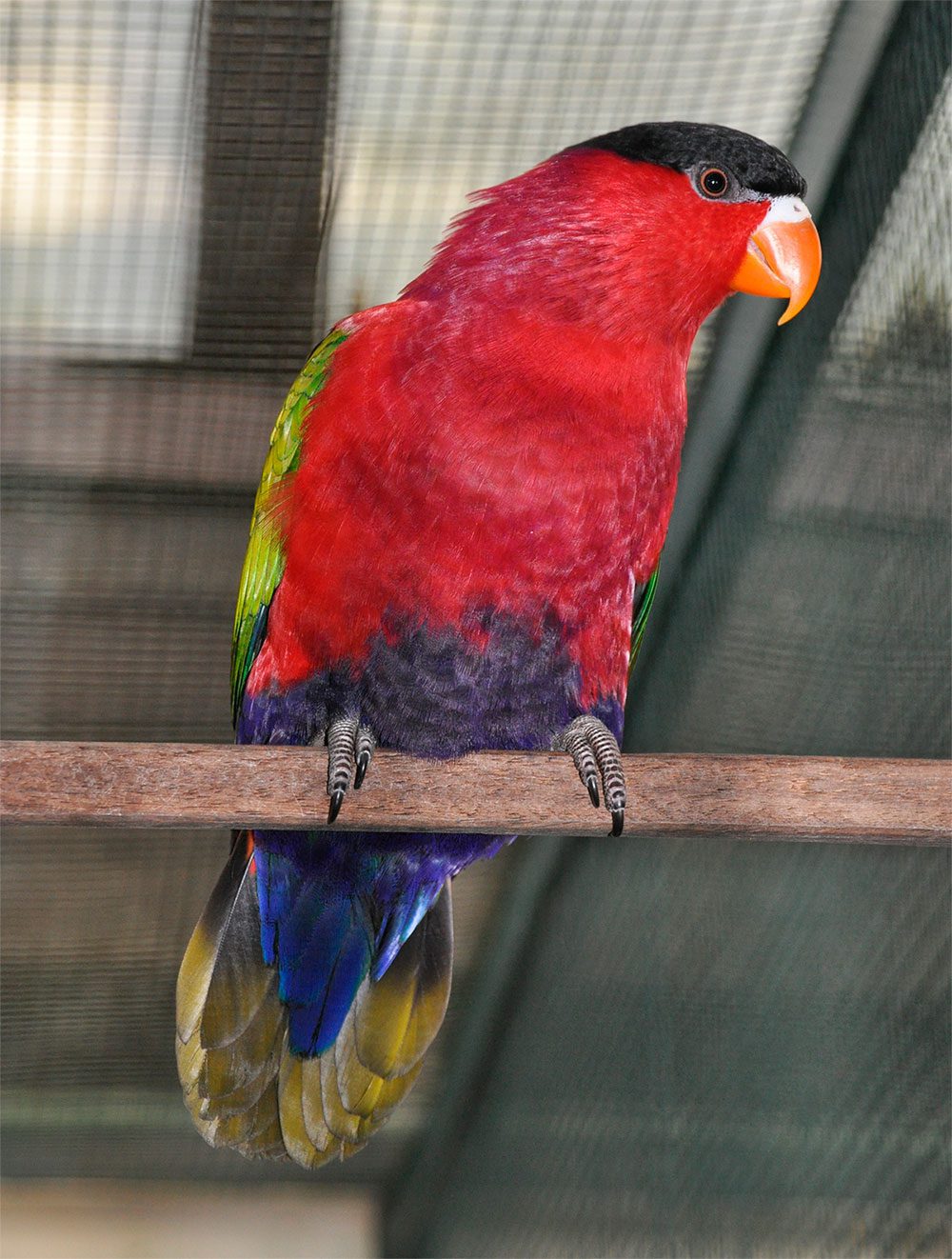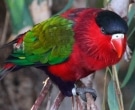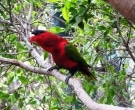Content |
|---|
Description
The Purple-bellied Lory (Lorius hypoinochrous) has an approximate length of 26 cm.. with a weight ranging between 200 and 240 g..
Hood black in color with blue purple sheen extending to the rear of the nape; rest of head red. Upperparts completely red with a band dark variable on the the mantle; upper mantle slightly more purple that the rest of them upperparts.
Primary coverts Bluish; remaining wing
Green with the internals of the flight feather in black color. Rojas the wing-coverts with black tips. The flight feather show a large patch yellow in the part internal.
Throat and chest, red, getting more purple towards the top belly; part low belly, the thighs and coverts, dark purple-blue. The parties above of the tail basically red, with the final part in dark blue (appears only teal at rest); undertail, opaque yellow with red hidden base.
Bill orange; cere (waxy soft swelling, containing the nostrils, at the base of the upper beak) white; Iris orange; legs black grey.
There is no significant difference between males and females. In general, the male has a bill a little stronger than the female.
The juveniles has belly pale purple color and peaks are more brownish.
- Sound of the Purple-bellied Lory.
Description 3 subspecies
-
Lorius hypoinochrous devittatus
(Hartert, 1898) – Differs by the absence of margins black in the large feathers underneath them wings.
-
Lorius hypoinochrous hypoinochrous
(Gray,GR, 1859) – Nominal.
-
Lorius hypoinochrous rosselianus
(Rothschild & Hartert, 1918) – Difference with the species rated by the fact of that has the chest the same red that the upper part of the abdomen.
Habitat:
Unlike in the Black-capped Lory, often found in coconut, mangroves and coastal vegetation (especially fond of coconut flowers); the Purple-bellied Lory also frequents low forests, the edges of these, high secondary forests, inhabited or partially cleared areas and gardens. Found individually, in pairs or in small groups of up to 10-20 birds. Ruidoso, visible and Active, they often live in trees or just above the canopy.
In the Island of Papua, they are distributed by the lowlands and foothills, in New Britain up to at least 450 m, in New Ireland until 750 m (where is sympathetic with the White-naped Lory) and up 1.600 metres in the Goodenough island.
Virtually nothing is known of the reproductive ecology of this species., Although is has been able to observe to them males in a, apparent, participation in the cortejo, with repetitive stretching of the neck and movements side of the head.
Reproduction:
Due to its extreme rarity, We know little about their reproductive behavior.
It is likely to be very similar to the of the Black-capped Lory (Lorius lory). This means a spawning two eggs and a incubation period of about 26 days.
Food:
The Purple-bellied Lory It feeds mainly in the canopy in noisy groups. Its diet natural consists of pollen, nectar, flowers, fruits, insects and their larvae, and probably seeds.
Usually see, sometimes, feeding is in company of the Sulphur-crested cockatoo and the Eclectus Parrot.
Distribution:
Size of the area of distribution (reproduction / resident): 61.900 km2
Endemic of the southeast of Papua New Guinea and surrounding island groups. On the island it reaches West, from Lae in the Huon Gulf to the North to Cape Rodney in the South. Is distributed in the islands of the archipelagos of D'Entrecasteaux and Louisiade, including (Goodenough, Fergusson, Normanby, Bentley, Misima Island, Tagula and Rossel, Islands Trobriands, Woodlark and Islands of the Bismarck Archipelago, including Umboi, Sakar, New Britain, New Ireland, Witu, Lolobau, Uatom, New Hanover, Tabar and Lihir.
common and locally abundant. World's largest population of 50.000 birds.
Distribution 3 subspecies
-
Lorius hypoinochrous devittatus
(Hartert, 1898) – Southeast of New Guinea, the D'Entrecasteaux archipelago. The Trobriand Islands and in all the Bismarck Archipelago.
-
Lorius hypoinochrous hypoinochrous
(Gray,GR, 1859) – Nominal. Misima Island and Tagula Islands of the Louisiade archipelago)
-
Lorius hypoinochrous rosselianus
(Rothschild & Hartert, 1918) – Rossel Island in the Louisiade archipelago
Conservation:
• Current IUCN Red List category: Least concern
• Population trend: Stable
The world population It has not been quantified, but the species appears to be common and abundant throughout its area of distribution.
Justification of the trend
Suspected that the population is stable in the absence of evidence of declines or substantial threats.
"Purple-bellied Lory" in captivity:
Extremely rare.
Alternative names:
– Purple-bellied Lory, Eastern Black-capped Lory, Purple bellied Lory, Stresemann’s Lory (ingles).
– Lori à ventre violet, Lori de Louisiade (French).
– Schwarzsteißlori, Louisiadenlori (German).
– Loris Hypoinochrous (Portuguese).
– Lori Ventrivinoso, Tricogloso de Streseman, Tricogloso de Vientre Púrpura (español).
scientific classification:
– Order: Psittaciformes
– Family: Psittaculidae
– Genus: Lorius
– Scientific name: Lorius hypoinochrous
– Citation: Gray,GR, 1859
– Protonimo: Lorius hypoinochrous
Images “Purple-bellied Lory”:
————————————————————————————————
“Purple-bellied Lory” (Lorius hypoinochrous)
Sources:
– Avibase
– Parrots of the World – Forshaw Joseph M
– Parrots A Guide to the Parrots of the World – Tony Juniper & Mike Parr
– Birdlife
– Photos:
1 – “Lorius hypoinochrous qtl1” by Quartl – Own work. Licensed under CC BY-SA 3.0 via Wikimedia Commons.
2 – Animal Photos – Enlace
3 – parrots-pictures
4 – by Bilder von Marion – papageien.org
5 – Free pet wallpapers – link
– Sounds: Frank Lambert (Xeno-canto)






